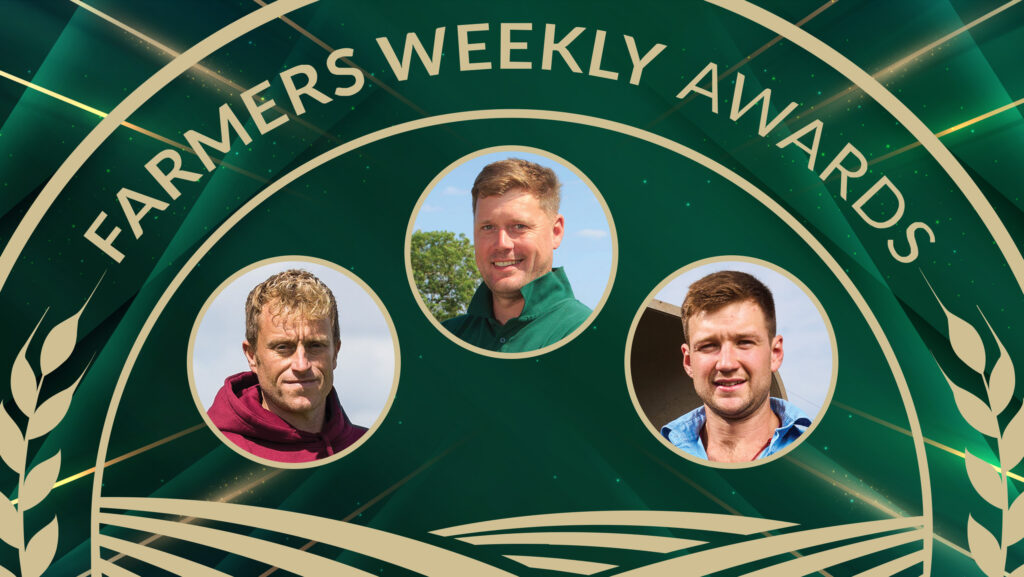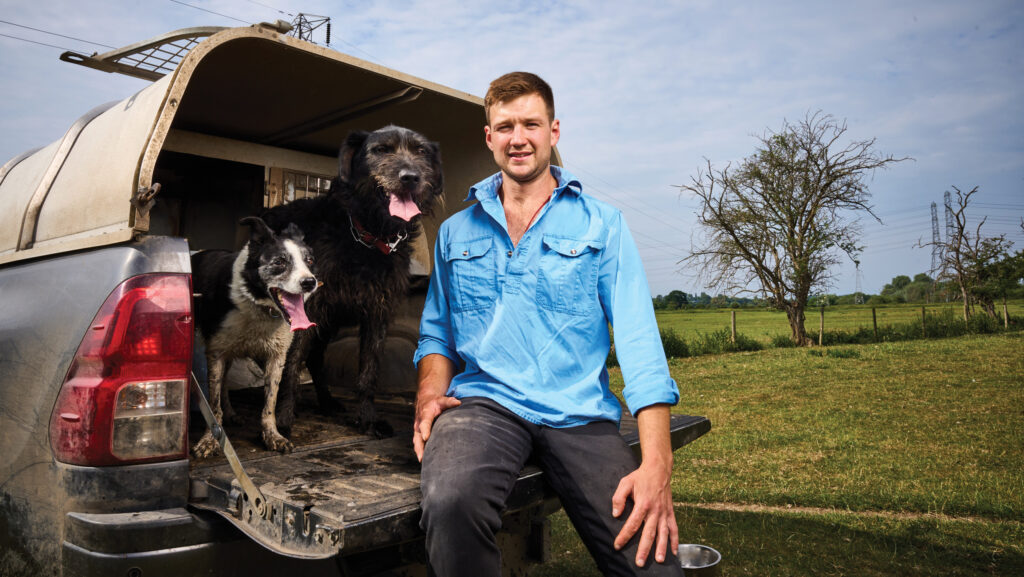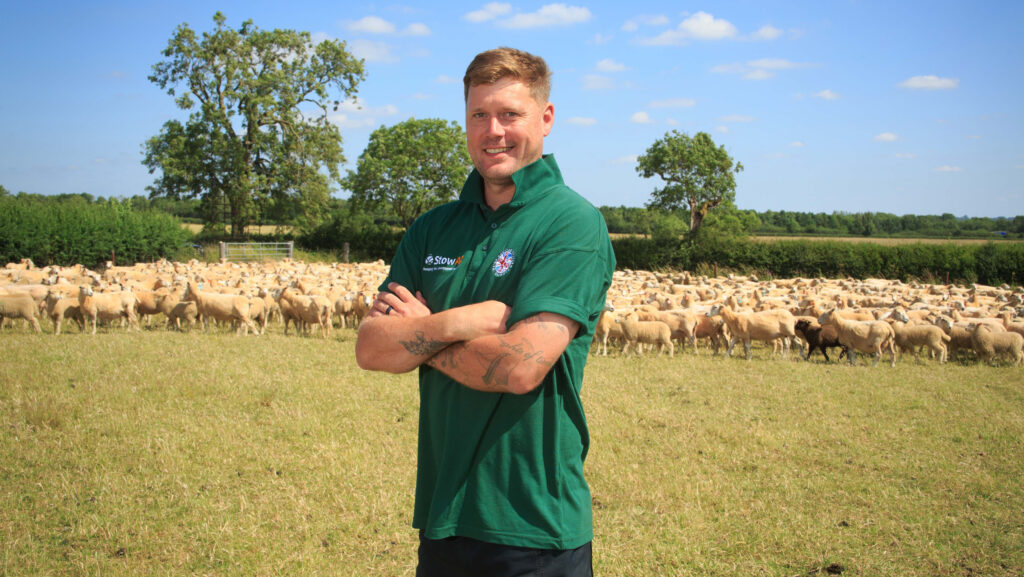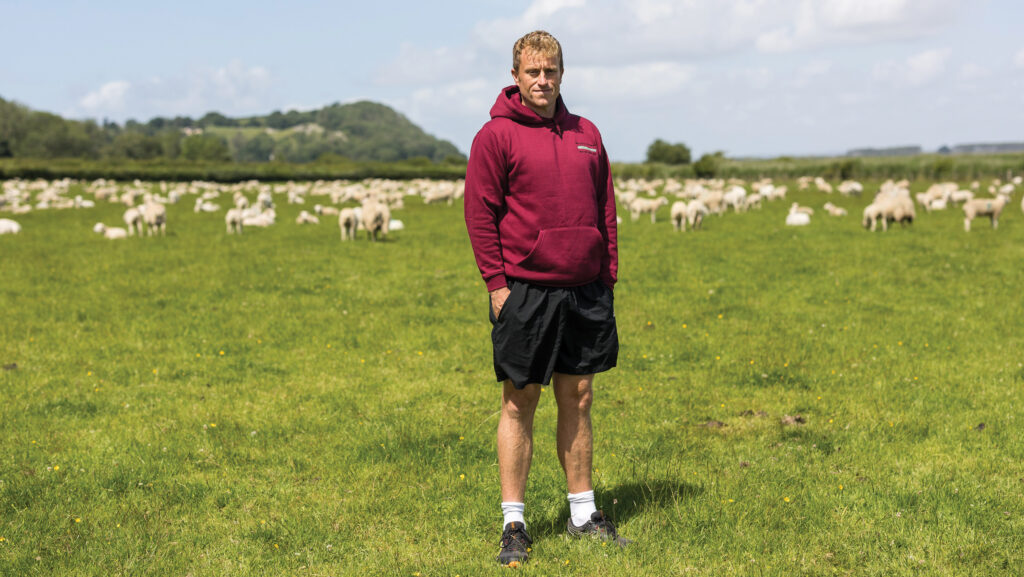FW Awards: Meet the 2025 Sheep Farmer of the Year finalists
 Dan Pritchard, James Horn and Tom Bird © John Wellings, Tim Scrivener, Oli Lees
Dan Pritchard, James Horn and Tom Bird © John Wellings, Tim Scrivener, Oli Lees The systems and challenges may vary, but all the finalists in the Sheep Farmer of the Year category share the drive and enthusiasm to get the best flock performance.
See also: FW Awards 2025: Meet the finalists
Finalists
- Tom Bird, Ferry Lane Farms, Derbyshire
- James Horn, JR Horn Agricultural Services, Northamptonshire
- Dan Pritchard, JR & DJ Pritchard, Gower Peninsula
The judges
- Moira Gallagher – Independent judge and farm consultant Moira has a specialist interest in sheep production and is based at SAC Consulting’s
St Boswells office. - Annie Carr – Last year’s Sheep Farmer of the Year winner, Annie produces fast-growing finished lambs from her crossbred flock in Herefordshire.
- Judith Tooth – Farmer’s Weekly’s Livestock editor, Judith, has a particular interest in the role of livestock in sustainable farming systems.
Tom Bird, Ferry Lane Farms, Derbyshire

Tom Bird © Oli Lees
Tom Bird has his fair share of challenges at Ferry Lane Farms.
River meadows flood in winter, ancient monuments prevent reseeding or sowing deep-rooting herbal leys, and short-term grazing lets make any significant investment unviable.
In addition, the predominantly light land is prone to burning up in late spring and summer unless there is adequate rainfall.
However, by adopting a flexible approach, Tom is making the most of what he has, running a high-input, high-output sheep system for his flock of 2,300 North Country Mules.
Tom returned home in 2017 to join his father, William, who started the farm from scratch.
Four years later, he became a partner in the business and now does 80% of the work.
Sheep system
Annual flock replacements are sourced direct, including 400 shearlings selected in July from a Cotswolds estate.
They are brought to the farm after tupping and having had abortion and toxoplamosis vaccinations.
On arrival, they are scab-dipped, vaccinated against foot-rot, foot-bathed, put on the Heptavac P system and drenched for worms and fluke.
Replacements stay quarantined from the rest of the flock until the following lambing. This system saves on winter grazing and prevents disease spread.
Previously, rams were bred on-farm, but Tom says he is better off “buying from someone who is at the top of their game with all the performance records to back them up”.
He now selects rams on estimated breeding values for growth and muscle depth.
As a result, lambs are on average 2kg heavier at eight weeks of age and achieve a carcass grade of R3L or better.
Lambing is indoors in early March, reaching a peak of 150-220 ewes daily.
Once lambed, they are fed 450g/day of a 19% ewe roll for about three weeks to ensure they hit peak lactation.
Fodder beet is fed ad-lib for the same period to bridge any potential forage gap.
Grazing and creep feeding
Four to six weeks after lambing, sheep are put in grazing groups of 150-200 ewes plus lambs.
Stocking rate on the permanent pasture is 7.5-10 ewes a hectare, depending on grass condition and likely impact of drought.
By contrast, grazing of high-clover reseeds at 12-17 ewes a hectare on bigger blocks of former arable land produces “tremendous” regrowth of grass.
Once in their allocated fields, the first 70% of lambs born are creep fed.
This ensures most are finished by July – average days to slaughter is 14-15 weeks – mitigating the risk of drought, and hitting the market before prices start to fall.
“It’s more cost-effective to creep-feed lambs from a young age, when they have a feed conversion ratio of 3:1, than after weaning, when it’s 7:1,” Tom reasons.
The remaining lambs are finished off grass – unless drought shifts the priority to selling stores to avoid robbing ewe ground.
Faecal egg counts are done every three to four weeks in the grazing season.
Data management
Tom uses a mobile handling system for weighing and monitoring body condition.
This is housed in a purpose-built, walk-through trailer, with all equipment to hand and under cover.
“It’s a key piece of kit for scale and efficiency – I couldn’t do without it,” he says.
He benchmarks performance informally with two farmer friends and belongs to a grazing discussion group.
Tom is also busy restoring a house at the farm with his partner, Gabriella Benyon, a land agent.
The numbers
- 690 average annual rainfall (mm)
- 202 area of land prone to flooding from Rivers Trent and Derwent (ha)
- 210 average scanning rate (%)
- 21 deadweight of finished lambs (kg)
- 1.75 lambs reared from each ewe put to the ram
Farm facts
- 162ha owned and 342ha rented, plus winter grazing of grass and cover crops, growing 311ha permanent pasture/improved grass; 137ha arable cropping; 56ha in environmental schemes
- 2,300 North Country Mules
- Lambing indoors
- Flock replacements bought in
- Suffolk, Texel, Charollais and Suffolk cross Texel rams
- Finished lambs sold to Tesco (Tesco Sustainable Lamb Group premium)
- 40-128m above sea level
- Forage maize grown in rotation for local dairy
- 40-70ha mown for hay, some sold; 25ha cut for silage
The judges liked
- Clear business focus and direction, and a pragmatic approach
- Innovative handling system
- Excellent stockmanship
- Good grassland management
- High levels of efficiency and organisation within day-to-day management
What the judges say
Tom’s flexible and pragmatic approach has resulted in a resilient sheep system, which he operates to a high standard, making best use of land
and labour resources.
James Horn, JR Horn Agricultural Services, Northamptonshire

James Horn © Tim Scrivener
Rejection for a county council tenancy was the best thing that could have happened, says new farming entrant James Horn.
It meant he was available when approached by an arable farmer looking to bring sheep into his business.
That 50:50 farming partnership gave James five years’ valuable experience running 650 ewes across two flocks.
By 2023, with a young family to support, James realised he needed to increase his income.
He decided to move on – the 400 North Country Mules were sold, leaving him with the New Zealand Romney flock, which he grew with the purchase of 160 shearlings.
Last autumn, he bought a further 160 draft ewes and ewe lambs.
Grazing management
He now runs an outdoor-lambing flock of 620 New Zealand Romney ewes and 225 ewe lambs, and intends all flock replacements from now on to be home-bred.
Without any land of his own, James has secured grazing around his base in Clipston, Northamptonshire, by establishing good working relationships with local landowners – including his former business partner.
Sheep graze rotationally on a mix of permanent pasture, cover crops and forage crops. No concentrates are fed, except to cade lambs.
Flock performance
Having increased flock size, James has since culled hard to maintain a low-input system.
Ewes scanned at 176% in 2024 and 173% in 2025, while lambing percentage increased from 158% to 165% over the same period.
As the amount of land available to him varies year-on-year, he focuses on lambs reared a ewe to monitor performance.
In 2024, this figure was 1.37, including ewe lambs lambed.
“I’ve worked hard with my vet to identify my main areas of losses last year – joint ill and Haemonchus – and put systems in place to reduce the risk of these losses again,” he says.
He now sprays all tag sites with NoBacz Navel and performs faecal egg counts every fortnight through the grazing season.
All replacements are vaccinated against enzootic abortion and toxoplasmosis. The whole flock is on the Heptavac-P system and is vaccinated to protect against lameness.
Pre-tupping blood samples are taken to check trace element status, with drenches or boluses used as required. Lambs are tested for fluke and trace elements after weaning.
Lambs are tagged at birth so weight gain can be tracked, and this is recorded digitally.
Ewe lambs are selected as replacements based on weight and performance and put to either Aberblack or Chamois tups.
After running with a teaser ram for two weeks, they are tupped for five weeks. Ewes are put to Romney tups for four weeks.
James benchmarks performance against other local farmers through a flock club that he helped his vet practice set up.
He also belongs to a grazing discussion group.
Further improvements
This year, alongside support from family, including his mum, Clare, who looks after the cade lambs, he hired a shepherd to help through the busiest three weeks of lambing.
This improved the standard of care and helped keep on top of tasks such as recording data. “It took so much pressure off, she was magic,” he says.
James’s next step is to establish A and B flocks to drive further improvements in performance and build overall numbers to 1,000 ewes.
His long-term goal is to own some land to give him, his wife, Charlotte (a health worker), and their children, Florence, five, and Arthur, three, more security.
The numbers
- 173 scanning rate in ewes (%)
- 4 barren rate in ewes (%)
- 64 average ewe weight (kg)
- 4 minimum quarantine period for incoming stock (weeks)
- 26.8 average 10-week weight of lambs (kg)
Farm facts
- 620 New Zealand Romney ewes and 225 ewe lambs
- New Zealand Romney tups
- Chamois and Aberblack tups used on ewe lambs
- 162ha grass, forage and cover crops rented for grazing from local landowners
- Lambing outdoors
- Replacements bred on-farm
- Finished lambs sold direct to Farmers Fresh, Kenilworth, plus sales to local butcher
- Excess breeding stock sold privately
- Vet Partners Sustainable Sheep Farmer of the Year 2023
The judges liked
- Collaborative approach to sourcing grazing
- Strong drive to succeed within industry
- Proactive relationship with vet
- Low-input, grass-based system
- Regular investigative animal health tests carried out
What the judges say
James has a clear, business-minded approach to his sheep system, regularly reviewing his costs and performance, and working closely with his vet to optimise flock health.
Dan Pritchard, JR & DJ Pritchard, Gower Peninsula

Dan Pritchard © John Wellings
Third-generation farmer Dan Pritchard calls the book of tide tables for Llanelli High Waters his bible.
He highlights the times in it – roughly one week in three – when his sheep must be brought off the saltmarshes and onto higher ground around Weobley Castle on the Gower peninsula.
Dan – who farms with brother Will and father Roland – has grazing rights for 1,500 ewes on the saltmarshes, which form part of the Burry Inlet and Loughor Estuary site of special scientific interest.
To reduce grazing pressure on this delicate habitat, flock size was reduced by one-third a decade ago as part of a whole-farm, low-input environment scheme.
Sheep system
Sheep breed has also changed, with Easycare ewes proving more suitable than the larger Welsh Mules they have mostly replaced.
At 65kg on average, this makes them a bit easier to rescue if they fall into a deep gulley, says Dan.
“Living on short, tough grass, they have to be pretty fit,” he adds.
Flock replacements are bought from a small number of trusted farms.
“The marsh is too harsh an environment for growing lambs over winter, and having an extra management group would add complexity to our simple system,” he explains.
Tups go in on 1 November, and scanning rate is a steady 160-165%.
Dan uses Primeras with high estimated breeding values, selecting for high growth rates and lambing ease.
e has recently bought two Beltex-type rams and will compare lamb performance and carcass traits.
After lambing outdoors on higher ground in April and early May, he manages a staggered release of ewes and lambs onto the saltmarsh, starting with early singles.
One lambing field is then used for camping, while a larger area is given to a weekend festival of music and running.
Lamb sales
All lambs are finished on farm. In season, they supply sister company Gower Saltmarsh Lamb – the first UK product to be awarded protected designation of origin status, in 2021.
On-farm butchery output has grown from 30 lambs in year one, to 35 a week between July and the end of December.
Remaining lambs are weaned in October and graze higher land before moving onto swedes for finishing in January. No concentrates are fed.
Cattle and poultry muck is spread on the grassland when conditions allow, and one pre-lambing grazing rotation is completed in February before set stocking.
Dan also makes 100 bales of haylage for outwintered ewes.
Dan uses his own testing kit to monitor faecal egg counts, which are consistently low.
Blood tests for fluke are done alternate years, and last year were negative.
The flock health plan also includes mineral boluses, abortion and foot-rot vaccines, and lambs receive a vitamin B12 supplement.
Plunge-dipping has successfully prevented scab for the past six years.
Flock performance
Dan benchmarks performance by taking part in the Aberystwyth Farm Business Survey.
While output – at 1.4 lambs a ewe – is slightly less than the top third of flocks, variable costs are very low, at £7.70 a ewe.
Production cost is calculated at £69.43 a lamb. He also compares figures with “big hitters” in a business discussion group and a grassland group.
Dan has to keep physically fit, as the numerous gulleys that dissect the saltmarshes mean checking and gathering the sheep must all be done on foot.
Although he has recently retired from the local football team, he is a keen runner and cyclist, encouraged by his girlfriend, Sian Harries, a PE teacher.
The numbers
- 165 scanning rate percentage
- 5 barren rate (%)
- 2 butchers on-farm, contracted for one day a week in season
- 910 lambs sold through on-farm cutting room in 2024
- 25 capacity of solar array on farm shed (kW)
Farm facts
- 101ha, across two blocks
- 1,000 ewes, mostly Easycare put to Primera rams
- Sheep graze saltmarshes except at high tide
- Yearlings bought in annually as flock replacements
- Lambing outdoors
- Lambs supplied to sister company Gower Salt Marsh Lamb in season, for sale online and in local shops and restaurants
- Remaining lambs sold to Dunbia or through local market
- Member of Farm Assured Welsh Livestock
- Runs small campsite and hosts Love Trails Festival
The judges liked
- System developed to maximise grazing on saltmarshes
- Dedicated to producing a high-quality lamb product
- Good use of marketing
- Low cost of production
- Diversified tourism income
What the judges say
Dan runs a well-thought-out sheep system with a low cost of production. He’s making the best of use of resources and has developed an excellent market for lamb from the saltmarsh.
A word from our sponsor

“Rumenco and Nettex are proud to sponsor this award, which recognises the contribution and commitment of sheep farmers to welfare, productivity and sustainability.”
Dr Alison Bond, Rumenco technical service manager, and Sarah Gallimore, Rumenco and Nettex technical associate
